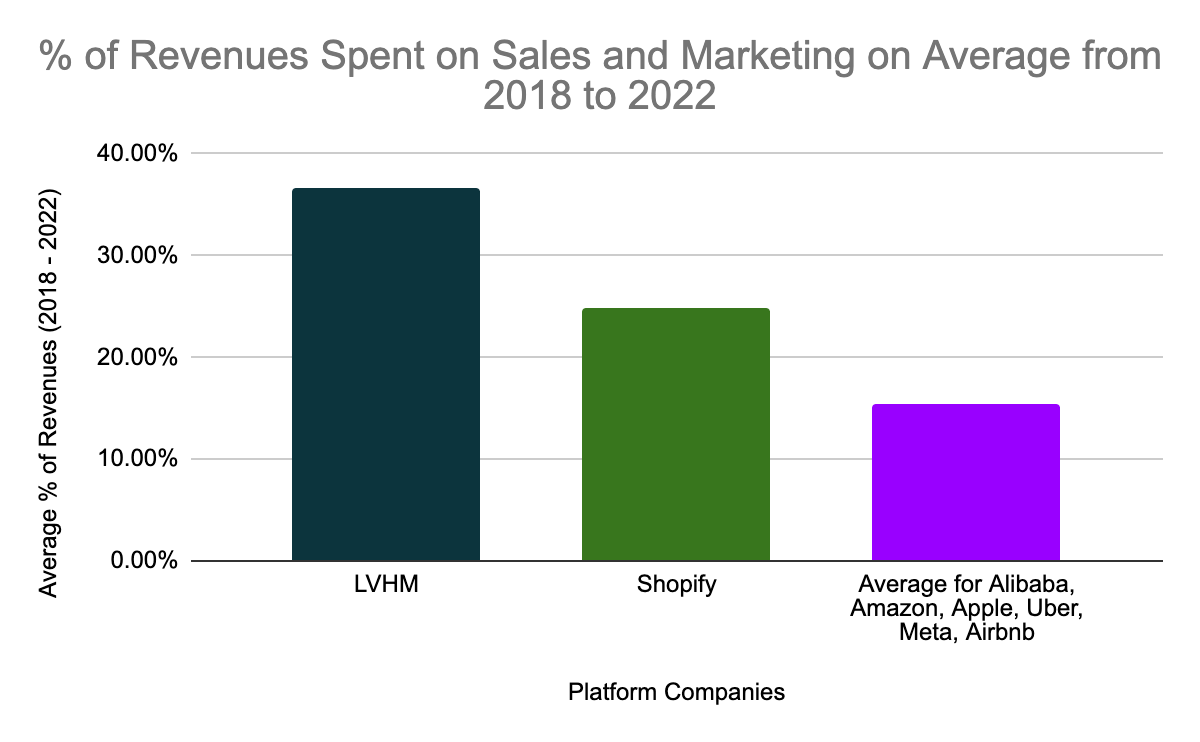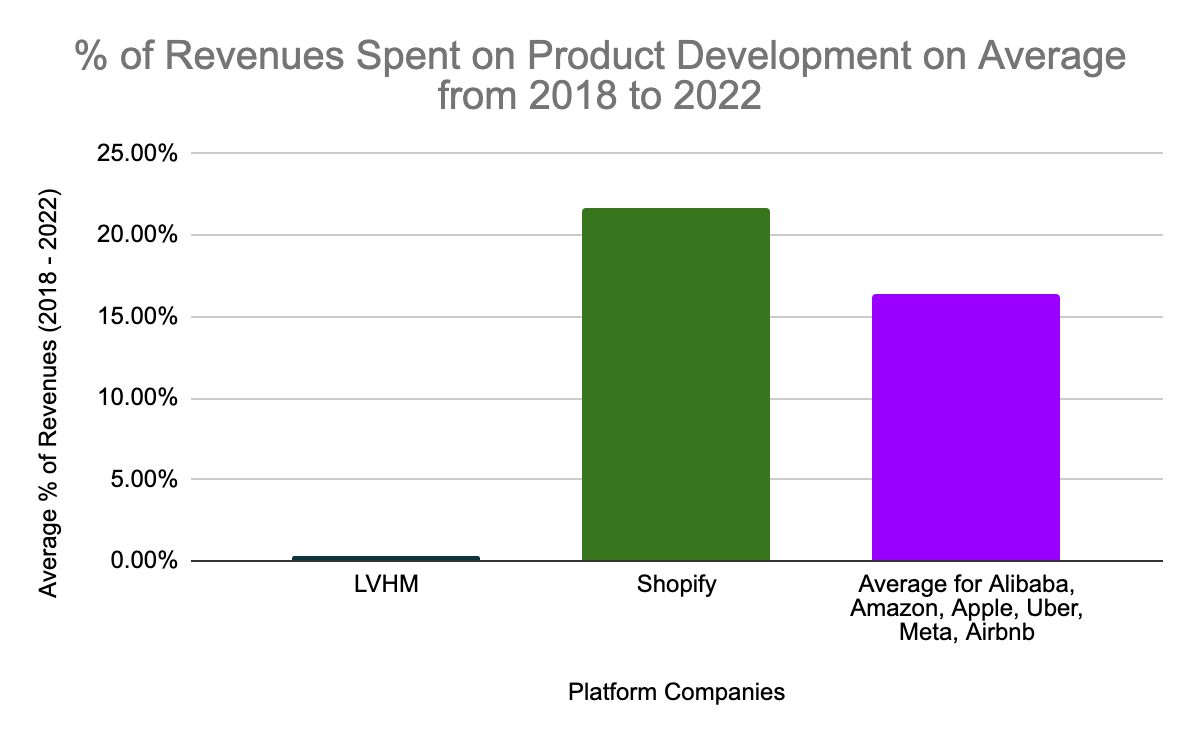How Does a Platform Work?
Understanding platform businesses using Shopify and LVMH as case studies.
To Investors,
Out of curiosity I decided to compare LVMH and Shopify as platform businesses, to understand what it takes to build a successful platform business.
One way to define a platform business is that it's an economy, which in turn enables smaller ecosystems to thrive in that economy.
In other words, a platform business is a foundation upon which countless other businesses, or even entire industries are built and/or empowered to thrive.
Shopify and LVMH share this fundamental concept. Both companies operate in the retail space yet their approaches are slightly different in that LVMH takes a more meticulous process-driven approach to empowering luxury brands under one umbrella, vs Shopify’s digital-first approach to empowering e-commerce businesses.
Shopify: Empowering E-Commerce Excellence
Shopify is a leading provider of essential internet infrastructure for e-commerce, offering tools to start, grow, market, and manage a retail business of any size.
The Shopify platform offers front-end software which enables merchants to easily display, manage, market and sell their products across multiple different sales channels; and an integrated backend to support the sales channels.
In and around that core software, Shopify ensures end to end support for the online seller, which also includes fulfilment through a partnership with Flexport (Shopify owns 13% of Flexport), Advertising and promotion of the seller’s offerings, Payments infrastructure, and a Loan facility for its online sellers.
We’ll use an e-commerce company called Drake Related as an example of how Shopify benefits online sellers…
Challenge
Drake Related wanted to collaborate with independent brands and artists for unique product launches. However, managing these partnerships, handling logistics, and shipping goods to customers presented challenges and was time-consuming.
Solution
To simplify their brand collaborations, Drake Related turned to Shopify Collective, a tool that enables them to discover, source, and sell products from independent brands on Shopify without dealing with logistics and inventory management.
Benefits of Shopify Collective
Simplified Partnerships: Drake Related found it easier to connect with like-minded brands.
Fast Deployment: They could set up brand collaborations on their website in just 20 minutes.
Efficient Audience Growth: 72% of sales involving products sourced through Collective came from first-time customers of the partner brands.
Streamlined Operations: Shopify Collective reduced the technical and logistical hurdles associated with adding new products to the website, coordinating orders, and handling packaging and fulfilment.
Expanding Product Offerings: Drake Related was able to select five brands for collaboration, adding unique products to those brands’ online stores, and creating an immersive shopping experience.
Automated Order Fulfilment: Orders placed on Drake Related's website are automatically sent to the supplier brands for fulfilment and shipping, streamlining the process further.
LVMH: The Luxury Ecosystem
LVMH on the other hand, is a well crafted ecosystem of independent luxury brands that share information and know-how. Each brand retains its unique identity and autonomy while enjoying the immense support provided by LVMH through a carefully curated supply chain, from sourcing to distribution.
Here are a few points that paint a picture of the value that LVMH provides to its brands:
Lessons learned
4 key principles for building a successful platform business are apparent.
Build a core foundational product that solves an essential system problem.
For Shopify this meant providing software to power an e-commerce platform - providing a one-stop shop for building, maintaining, and scaling an e-commerce business.
For LVMH this is putting processes in place that enable luxury brands to continue providing high quality luxury products, independent of “competition” or economic forces.
Cross-sell complementary products to entrench switching costs for platform participants.
For Shopify the complementary products are payments, fulfilment infrastructure, an advertising and marketing machine to promote sites on the Shopify platform, capital procurement for sellers, a money management tool for sellers, and additional admin and business management tools.
For LVMH the complementary products are 1) the acquisition of digital tools, acquiring additional brands, and trade names; and 2) the acquisition of vineyard land for production and other production & logistics infrastructure - all of which combine to create an ecosystem that facilitates success, without which the luxury brands may not have the global reach that they have.
Protect your core system architecture and intellectual property to protect the core revenue stream.
For Shopify their core revenue is the their subscription revenues for on-boarding sellers and enabling them to build retail websites; and it protects this core offering by a) offering Merchant solutions (cross-selling products) which enable an e-commerce business to go from existing to thriving; b) spending heavily on product development, sales and marketing; and c) offering additional infrastructure which is available on a tiered basis - basically as the size of your business grows you unlock more solutions that will help you continue to scale.
For LVMH their core revenue is actually the revenue generated by all of the luxury brands under its umbrella, which come as a result of LVMH acquiring nearly ALL of the major luxury brands on a global scale, and cornering the market to where “competition” isn't really a thing.
The idea being that, again, you need to entrench switching costs for users of your platform.
Can any of the brands under LVMH really operate independently? Why would they even want to be independent?
Can any of the online sellers using Shopify really operate independently? Why would they even want to try?
Maintain high investment towards fast iteration and product improvements.
I’ve mentioned the investments LVMH has made for its business groups above. Additionally, since 2018 LVMH has on average spent 37% of its revenues on Sales and Marketing.
Since 2018, on average Shopify has spent 25% of its revenues on Sales and Marketing, and 22% of its revenues on Research and Development.
Benefits and Challenges
Building a successful platform is no small feat, but it offers numerous advantages:
Data Advantage: As the platform owner you can see everything that the platform users are doing, which enables you to anticipate trends and develop unique products that can improve the platform - and if you do a good job you can establish switching costs amongst your users. A major competitive advantage.
Network effects: As more users come on the platform, the platform becomes more valuable because you enable synergies - promoting innovation and information sharing.
Creating a new normal: Tobi Lutke said that he founded Shopify because he saw that when he was trying to build an e-commerce store to sell surfboards, all the digital tools he needed were difficult to find, and time consuming to put together.
Diverse revenue streams:
As an investment holding company, LVMH has a majority stake in all of the brands under its umbrella, so all of the revenues from all of these brands combine under LVMH.
With Shopify, as they see the e-commerce businesses grow on the Shopify Platform, over time Shopify can create and promote products built in-house, instead of paying third-party service providers.
A few examples are Shopify Payments (payment processing), an internal Advertising engine, Shopify Capital (merchant cash advance/loan service), Shopify Balance (money management), and Shop Pay (buy-now-pay-later).
The in-house versions can run on a leaner team because they only have to service users on Shopify at first, but as more users onboard onto these in-house solutions, you can branch these out and make them available on other platforms.
However, even with all the promise of those advantages, to build a successful platform, you will have to spend heavily to drive adoption, and create and maintain value and trustworthiness.
Considering the above charts, it's important to note that the true value of a platform lies in the value of the ecosystem that it creates.
For Shopify, we can use the Gross Merchandise Value to measure value.
For LVMH we can use the company’s worldwide revenues to measure value.
In conclusion, to understand platform businesses, it was important to compare two functionally different businesses that operate in the same industry - and note that “platform” does not equal digital only. Through understanding how LVMH and Shopify work, key principles on how to build a successful platform business were highlighted. Platforms are hard, but done correctly and with focused aggression, a successful platform can unlock a colossal amount of value.
Sources
https://www.lvmh.com/group/about-lvmh/model-lvmh/
https://www.glenmorangie.com/being-part-of-lvmh
https://fourweekmba.com/lvmh-group-business-model/
https://r.lvmh-static.com/uploads/2023/03/lvmh_2022_annual-report.pdf
https://r.lvmh-static.com/uploads/2023/02/lvmh-comptes-consolides-2022-va.pdf
https://sloanreview.mit.edu/article/how-companies-become-platform-leaders/







